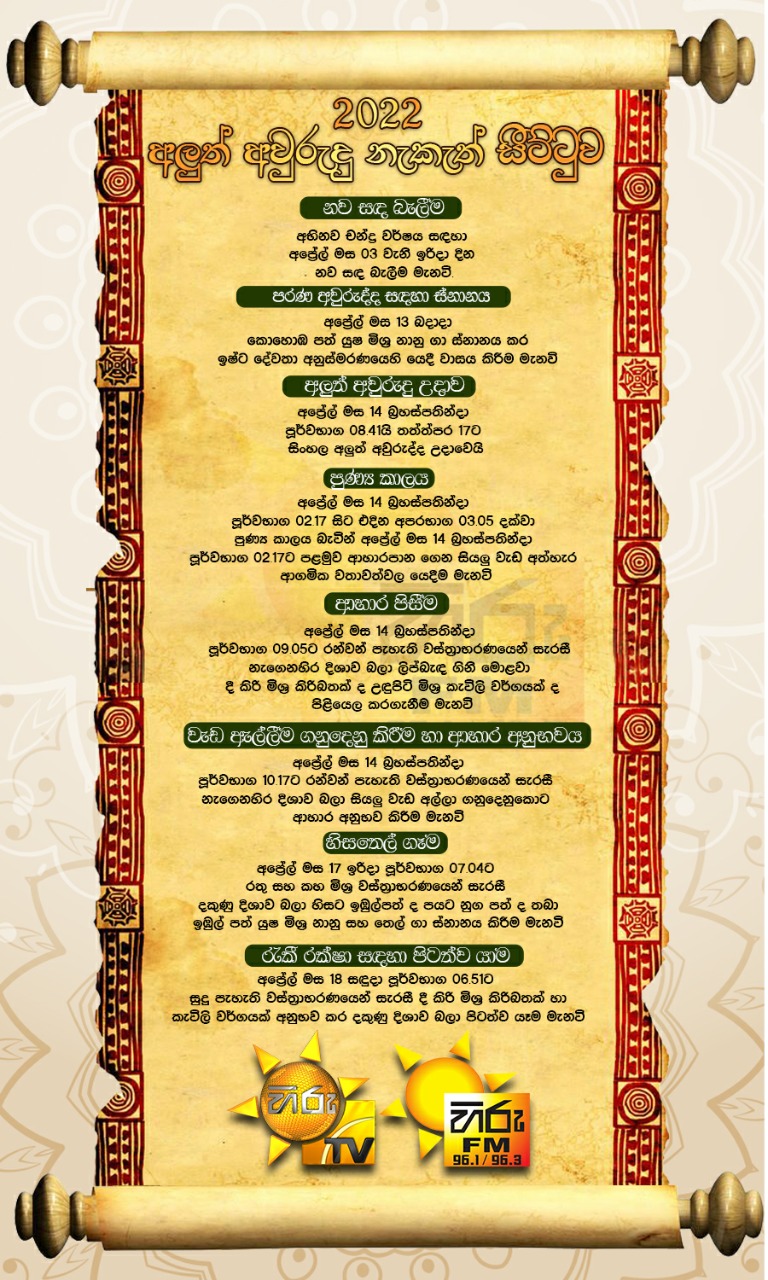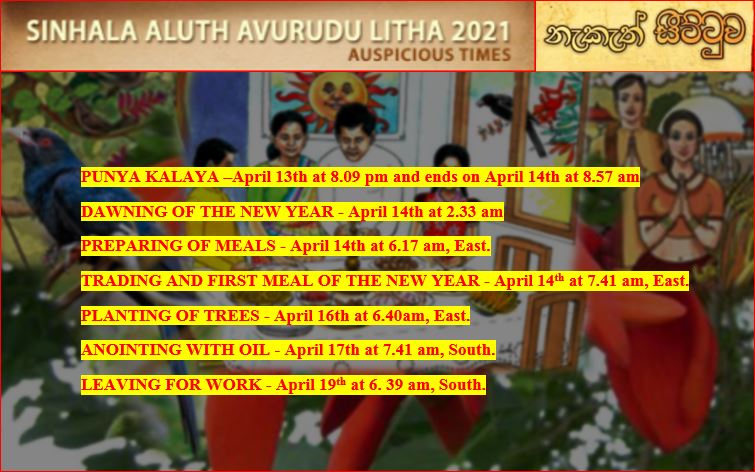Sinhala Tamil New Year Auspicious Times Avurudu Nakath Litha 2022
New Year Auspicious Times Aurudu Nakath 2022. As Sri Lankans across the country prepare to usher in the Sinhala – Tamil New Year (Aluth Avurudda) in 2022 April.Officials urged the public to observe Sinhala and Tamil New Year rituals at home in a safe and subdued manner given the current situation in the country. We bring you the auspicious times…

BATHING FOR OLD YEAR
Bathing for old year falls on Monday the 12th of April
PUNYA KALAYA
Punya Kalaya begins on 13th of April at 8.09 pm and ends on 14th of April at 8.57 am
DAWNING OF THE NEW YEAR
New Year will dawn at 2.33 am on Wednesday the 14th of April
PREPARING OF MEALS
Preparing meals for the New Year should begin at 6.17 am on the 14th of April, dressed in light green looking forwards the East.
TRADING AND FIRST MEAL OF THE NEW YEAR
The tradition of trading and consuming the first meal of the New Year is to be done at 7.41 am on the 14th of April, dressed in light green looking forwards the East.
THE NEW MOON
The new moon can be seen on Friday the 16th of April
PLANTING OF TREES
Planting of trees take place on Friday the 16th April at 6.40am while facing East
ANOINTING WITH OIL
Anointing the head with oil is set for Monday the 17th of April at 7.41 am, dressed in Blue looking forwards the South.
LEAVING FOR WORK
Leaving for work in the New Year is set for 6. 39 am on Monday the 19th of April, dressed in White looking forwards the South.

A set of health and precautionary guidelines in relation to the celebration of the Sinhala and Tamil New Year signed by the Director-General of Health Services, Dr Asela Gunawardena has been issued.
According to the guidelines, people can celebrate the Sinhala and Tamil New Year at home by observing the new moon, bathing for the old year, consuming meals, engaging in work and financial transactions and the anointing of oil.
The guidelines add charitable activities should be carried out at home during the auspicious time (Punya Kaalaya) and stressed that if one goes to temples or kovils during this time, they should follow all hygienic practices.
The New Year Guidelines issued by the Ministry of Health added visiting of relatives, sharing of avrudu treats and outdoor New Year festivities should be minimized as much as possible.
The guidelines also include health measures that need to be followed during New Year’s games and activities, including the crowning of the Avrudu Kumaraya and Kumariya, cycling races, marathon races.
The guidelines have stressed that conducting of tug-of-war and pillow wrestling (Kotta Pora) is not suitable, given the present pandemic situation.
Officials urged the public to observe Sinhala and Tamil New Year rituals at home in a safe and subdued manner given the current situation in the country. Issuing a press release on the Sinhala and Tamil New Year auspicious times, the Ministry requested the people not to leave their houses or organize large celebrations, but to observe the rituals with family members and engage in religious activities at home in a simple manner.
An auspicious time to plant a sapling has been recently added as a new feature to the New Year rituals. This ‘nekatha’ falls on April 16 at 6.40 am.
Sinhala Tamil New Year Auspicious Times Avurudu Nakath Litha 2021 – Sinhala

Twitter introduces Sinhala and Tamil hashtags and emoji for Sinhala and Tamil New Year. The hashtags #අලුත්අවුරුද්ද #අවුරුද්ද #சித்திரைப்புத்தாண்டு #பிலவவருடம் included with a Emoji of an Elephant. Earlier Twitter introduced Emojis for Vesak and StayHome.
Sinhalese New Year, generally known as Aluth Avurudda (Sinhala: අලුත් අවුරුද්ද) in Sri Lanka, is a Sri Lankan holiday that celebrates the traditional New Year of the Sinhalese people in Sri Lanka. It is a major anniversary celebrated by not only the Sinhalese people but by most Sri Lankans. The timing of the Sinhala New Year coincides with the new year celebrations of many traditional calendars of South and Southeast Asia. The festival has close semblance to the Tamil New year and other South and Southeast Asian New Years. It is a public holiday in Sri Lanka. It is generally celebrated on 13 April or 14 April and traditionally begins at the sighting of the new moon
